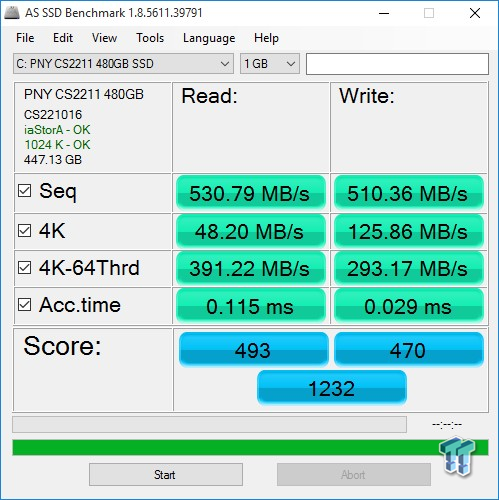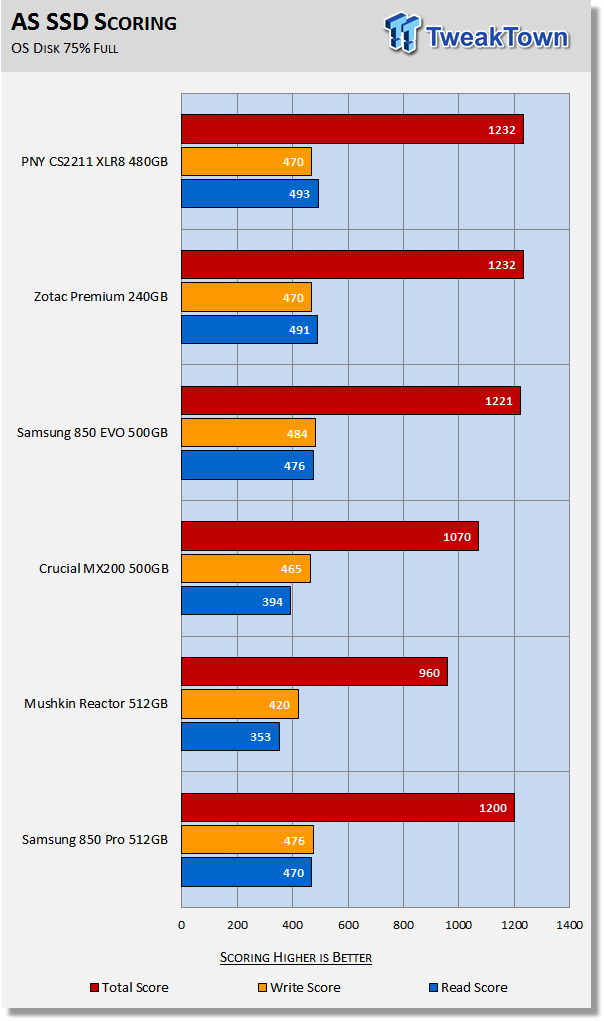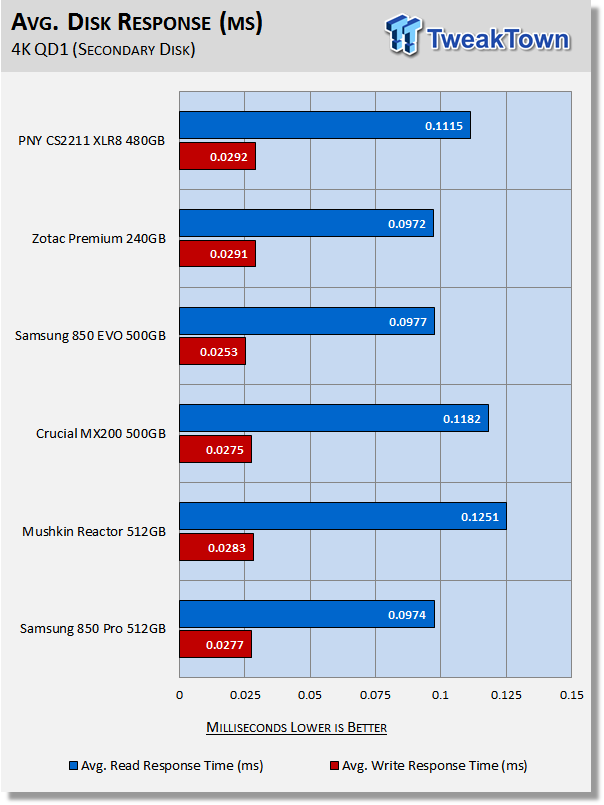
The Bottom Line
Introduction, Drive Specifications, Pricing and Availability

Phison's PS3110-S10-X quad-core, 8-channel controller, or "S10", as we will refer to it going forward, has emerged as the leading third-party SATA III controller on the market. The S10, when paired with quality MLC flash, is capable of delivering even better sequential performance than Samsung's venerable 850 Pro. Phison's S10 controller is capable of being paired with TLC or MLC flash arrays in capacities of up to 2TB; making it the most versatile SATA controller on the market today. We've seen Phison's S10 paired with Toshiba A19nm MLC/TLC and 15nm TLC flash and even 16nm Micron flash, but this is the first time we have a drive that matches the S10 with Toshiba's 15nm planar MLC flash.
Aside from Samsung's 16nm planar flash, which is only found on OEM Samsung SSDs, Toshiba's 15nm MLC planar flash has proven to be the most potent low-cost MLC flash on the market. PNY's CS2211 is the first of undoubtedly many SSDs to feature this low-cost potent controller/flash combination. As all of you know, reliability is every bit as important as performance. Phison controllers are among the industry's most reliable with integrated features like End-to-End Data Path Protection, SmartECC, SmartRefresh, SmartFlush, Advanced wear-leveling, and garbage collection. To assure quality and reliability, PNY's SSDs undergo rigorous validation and durability testing that includes hundreds of qualification tests, and over 10,000 hours of validation testing.
Inevitably all SATA SSDs will be compared to Samsung's potent 850 Series. None have been able to match the overall performance of the 850's, so what we are looking for as an alternative, are SSDs that perform almost as well at a price that is far enough below that of the 850 Series SSDs to be an attractive option. PNY's CS2211 XLR8 480GB SATA III SSD is priced right about $100-$115 less than Samsung's 512GB 850 Pro. We feel this price difference makes the CS2211 a very attractive option because you won't be giving up a lot of performance, certainly not a noticeable amount. Priced at just $132, you can damn near buy two PNY CS2211XLR8 480GB SSDs for the price of one 512GB 850 Pro and run them in RAID 0 for double the performance and capacity.
PNY uses their "XLR8" moniker to denote their highest performing hardware solutions, meaning the CS2211 XLR8 is their best performing SATA based SSD. Let's closely examine the performance of PNY's latest and greatest SATA III SSD.
Specifications

PNY's CS2211 XLR8 2.5"x7mm SATA III SSD is available in three capacities: 240GB, 480GB, and 960GB. The 480GB model we have on the bench has the following factory specifications:
Sequential Read: up to 565 MB/s. Sequential Write: up to 540 MB/s. Max 4K Random Read Speed: up to 95,000 IOPS. Max 4K Random Write Speed: up to 95,000 IOPS.
The CS2211 XLR8 retail package includes Acronis HD cloning software and a 2.5mm stick-on plastic spacer. PNY backs the CS2211 XLR8 with a four-year warranty. A four-year warranty is a year longer than any S10 powered SSD we've seen to date. This is a testament to the confidence that PNY has in their choice of quality components and their rigorous validation process. PNY does not list a TBW (Total Bytes Written) limit during the four-year warranty period.
Drive Details
PNY CS2211 XLR8 480GB SATA III SSD

Retail packaging features an image of the enclosed SSD on the front of the box. The front of the packaging advertises the enclosed drive's capacity, four-year warranty, and included Acronis migration software.

The rear of the packaging lists the drive's sequential performance specifications, MTBF rating of two million hours, included accessories, and various bits of relevant information.

Inside the packaging is the drive itself, a stick-on plastic spacer, and a printed user guide that includes an Acronis key.

The top of the drive's black aluminum snap-together enclosure is covered with an attractive label that has a carbon fiber look to it.

The back half of the drive's enclosure features a manufacturer's label listing the particulars of the drive.

The PCB snaps into place on the top half of the drive's enclosure.

This half of the PCB features the drive's S10 controller, eight 32GB 15nm Toshiba MLC flash packages, and a single NANYA branded 512MB DDR3 1600MHz cache package.

This side of the PCB houses the remaining eight Toshiba MLC flash packages.

A detailed view of the Phison PS3110-S10-X quad-core, eight-channel SATA III controller that powers the CS2211 XLR8.

A detailed view of one of the sixteen 32GB Toshiba 15mn MLC TSOP flash packages that populate the PCB.

A detailed view of the drive's NANYA branded 512MB DDR3 1600 MHz cache package.
Test System Setup and Properties
Jon's Consumer SSD Review Test System Specifications
- Motherboard: ASRock Extreme9 Z97 - Buy from Amazon
- CPU: Intel Core i7 4790K @ 4.8GHz - Buy from Amazon / Read our review
- Cooler: Swiftech H2O-320 Edge - Buy from Amazon / Read our review
- Memory: Corsair Dominator DDR3 32GB 2400MHz - Buy from Amazon
- Video Card: Onboard Video
- Case: IN WIN X-Frame - Buy from Amazon / Read our review
- Power Supply: Seasonic Platinum 1000 Watt Modular - Buy from Amazon / Read our review
- OS: Microsoft Windows 10 Professional 64-bit - Buy from Amazon
- Drivers: Intel RAID option ROM version 13.0.0.2075 and Intel RST driver version 13.6.0.1002
We would like to thank ASRock, Crucial, Intel, Corsair, RamCity, IN WIN, and Seasonic for making our test system possible.
Drive Properties

The majority of our testing is performed with our test drive as our boot volume. Our boot volume is 75% full for all OS Disk "C" drive testing to replicate a typical consumer OS volume implementation. We feel that most of you will be utilizing your SSDs for your boot volume and that presenting you with results from an OS volume is more relevant than presenting you with empty secondary volume results.
System settings: Cstates and Speed stepping are both disabled in our systems BIOS. Windows High-Performance power plan is enabled. Windows write caching is enabled, and Windows buffer flushing is disabled. We are utilizing Windows 10 Pro 64-bit OS for all of our testing except for our MOP (Maxed-Out Performance) benchmarks where we switch to Windows Server 2008 R2 64-bit.
Synthetic Benchmarks – ATTO & Anvil Storage Utilities
ATTO
Version and / or Patch Used: 2.47
ATTO is a timeless benchmark used to provide manufacturers with data used for marketing storage products.

Compressible sequential read/write transfers max out at 564/545 MB/s. Keep in mind this is our OS volume, and it is filled to 75% of its total capacity. Maximum sequential read performance is achieved at a 4MB transfer size, maximum sequential write performance at 8MB transfers.
Sequential Write

The CS2211 runs even with Mushkin's Reactor up to 8K file transfers and leads the field at 64K-8MB transfer sizes.
Sequential Read

The CS2211 runs strong throughout the test and leads the field at 2MB-8MB transfer sizes.
Anvil Storage Utilities
Version and / or Patch Used: 1.1.0
Anvil's Storage Utilities is a storage benchmark designed to measure the storage performance of SSDs. The Standard Storage Benchmark performs a series of tests; you can run a full test or just the read or write test, or you can run a single test, i.e. 4k QD16.

Scoring

Anvil's scoring gives a good indication of a drive's overall performance. PNY's CS2211 scores well over 5000 which is always a good indication that a drive is capable of delivering top-notch performance. ZOTAC's Premium SSD is a similarly configured to the CS2211 except it utilizes Toshiba A19nm MLC flash. A19nm flash delivers slightly better 4K random read performance, resulting in a slightly better overall score.
(Anvil) Read IOPS through Queue Depth Scale

Here we can see that ZOTAC's Premium SSD with A19nm MLC flash delivers better random read performance than PNY's CS2211.
(Anvil) Write IOPS through Queue Scale

Random write performance of both the CS2211 and ZOTAC Premium are very similar with both S10-powered MLC drives leading the field at QD8-32. Mushkin's Reactor lags way behind the rest of the field and is something we can point to as a reason why we believe Toshiba 15nm MLC flash is superior to Micron 16nm MLC flash.
Synthetic Benchmarks - CrystalDiskMark & AS SSD
CrystalDiskMark
Version and / or Patch Used: 3.0 Technical Preview
CrystalDiskMark is disk benchmark software that allows us to benchmark 4k and 4k queue depths with accuracy. Note: Crystal Disk Mark 3.0 Technical Preview was used for these tests since it offers the ability to measure native command queuing at QD4.


This backs up what we saw with Anvil's testing. The A19nm flash equipped ZOTAC Premium delivers superior random read performance in comparison to PNY's 15nm equipped CS2211. However, 15nm flash delivers slightly better sequential and 512K read performance.

Based on sequential performance, this is a clear win for the PNY CS2211. The CS2211 also delivers stout 4K random write performance.
AS SSD
Version and / or Patch Used: 1.7.4739.38088
AS SSD determines the performance of SSDs. The tool contains four synthetic as well as three practice tests. The synthetic tests are to determine the sequential and random read and write performance of the SSD.


AS SSD is a demanding test, and the CS2211 does not disappoint. PNY's CS2211 is able to match our highest recorded score for any SATA SSD running as our OS disk filled to 75% of its capacity. In fact, if you look at the read score, it is the highest we've recorded to date.
Benchmarks (Trace-Based OS Volume) - PCMark Vantage, PCMark 7 & PCMark 8
Moderate Workload Model
We categorize these tests as indicative of a moderate workload environment.
PCMark Vantage - Hard Disk Tests
Version and / or Patch Used: 1.2.0.0
The reason we like PCMark Vantage is because the recorded traces are played back without system stops. What we see is the raw performance of the drive. This allows us to see a marked difference between scoring that other trace-based benchmarks do not exhibit. An example of a marked difference in scoring on the same drive would be empty vs. filled vs. steady state.
We run Vantage three ways. The first run is with the OS drive 75% full to simulate a lightly used OS volume filled with data to an amount we feel is common for most users. The second run is with the OS volume written into a "Steady State" utilizing SNIA's guidelines. Steady state testing simulates a drive's performance similar to that of a drive that been subjected to consumer workloads for extensive amounts of time. The third run is a Vantage HDD test with the test drive attached as an empty, lightly used secondary device.
OS Volume 75% Full - Lightly Used

OS Volume 75% Full - Steady State

Secondary Volume Empty - FOB

There's a big difference between an empty drive, one that's 75% full/used, and one that's in a steady state.

The important scores to pay attention to are "OS Volume Steady State" and "OS Volume 75% full." These two categories are most important because they are indicative of typical of consumer user states. When a drive is in a steady state, it means garbage collection is running at the same time it's reading/writing. This is exactly why we focus on steady state performance.
Both S10-powered SSDs are capable of delivering class leading Vantage scores when empty. The CS2211 delivers the best empty score we've ever recorded. However, empty scores are meaningless which is THE reason we test the way we do. With data on the drives, a different picture emerges and the CS2211 and ZOTAC Premium fall to the bottom of our test pool. We do note that the CS2211 offers better performance than ZOTAC's Premium SSD across the board, which is a pleasant surprise.
PCMark 7 - System Storage
Version and / or Patch Used: 1.4.0
We will look to Raw System Storage scoring for evaluation because it's done without system stops and, therefore, allows us to see significant scoring differences between drives.
OS Volume 75% Full - Lightly Used


Again, the CS2211 outperforms ZOTAC's Premium SSD, but both are outperformed by the rest of the drives in our test pool.
PCMark 8 - Storage Bandwidth
Version and / or Patch Used: 2.4.304
We use PCMark 8 Storage benchmark to test the performance of SSDs, HDDs, and hybrid drives with traces recorded from Adobe Creative Suite, Microsoft Office, and a selection of popular games. You can test the system drive or any other recognized storage device, including local external drives. Unlike synthetic storage tests, the PCMark 8 Storage benchmark highlights real-world performance differences between storage devices.
OS Volume 75% Full - Lightly Used


PCMark 8 is the most intensive moderate workload simulation we run. With respect to moderate workloads, this test is what we consider the best indicator of a drive's performance. This time, the CS2211 outperforms Mushkin's Reactor but falls well short of our performance leader, the 850 EVO.
Benchmarks (Secondary) - Max IOPS, Response & Transfer Rates
Iometer - Maximum IOPS
Version and / or Patch Used: Iometer 2014
We use Iometer to measure high queue depth performance. (No Partition)
Max IOPS Read

Max IOPS Write


With our configuration, we are able to easily exceed PNY's 95K maximum read IOPS specification. The CS2211 delivers the highest read IOPS of our test pool. We were not able to achieve PNY's 95K maximum write IOPS specification, falling short by roughly 6,500 IOPS. However, if we look back at Anvil, we were able to reach 92K IOPS with data on the drive. Still, both figures fall short of PNY's 95K specification, which has us wondering, how did they come up with that specification?
Iometer - Disk Response
Version and / or Patch Used: Iometer 2014
We use Iometer to measure disk response times. Disk response times are measured at an industry accepted standard of 4K QD1 for both write and read. Each test runs twice for 30 seconds consecutively, with a 5-second ramp-up before each test. We partition the drive/array as a secondary device for this testing.
Avg. Write Response

Avg. Read Response


More evidence that A19nm flash delivers superior random read performance than 15nm flash. The ZOTAC Premium delivers the best read response in our test pool.
DiskBench - Directory Copy
Version and / or Patch Used: 2.6.2.0
We use DiskBench to time a 28.6GB block (9,882 files in 1,247 folders) composed primarily of incompressible sequential and random data as it's transferred from our DC P3700 PCIe NVME SSD to our test drive. We then read from a 6GB zip file that's part of our 28.6GB data block to determine the test drive's read transfer rate. Our system is restarted prior to the read test to clear any cached data, ensuring an accurate test result.
Write Transfer Rate

Read Transfer Rate


The CS2211 delivers class leading read transfer rates, tied with the 850 Pro for the top spot in our test pool. A write transfer rate of 417 MB/s is excellent; however, it is a bit lower than all but Mushkin's Reactor.
Benchmarks (Secondary Volume) - PCMark 8 Extended
Futuremark PCMark 8 Extended
Heavy Workload Model
PCMark 8's consistency test simulates an extended duration heavy workload environment. PCMark 8 has built-in, command line executed storage testing. The PCMark 8 Consistency test measures the performance consistency and the degradation tendency of a storage system.
The Storage test workloads are repeated. Between each repetition, the storage system is bombarded with a usage that causes degraded drive performance. In the first part of the test, the cycle continues until a steady degraded level of performance has been reached. (Steady State)
In the second part, the recovery of the system is tested by allowing the system to idle and measuring the performance after 5-minute long intervals. (Internal drive maintenance: Garbage Collection (GC)) The test reports the performance level at the start, the degraded steady-state, and the recovered state, as well as the number of iterations required to reach the degraded state and the recovered state.
We feel Futuremark's Consistency Test is the best test ever devised to show the true performance of solid state storage in an extended duration heavy workload environment. This test takes on average 13 to 17 hours to complete and writes somewhere between 450GB and 14,000GB of test data depending on the drive. If you want to know what an SSDs steady state performance is going to look like during a heavy workload, this test will show you.
Here's a breakdown of Futuremark's Consistency Test:
Precondition phase:
1. Write to the drive sequentially through up to the reported capacity with random data.
2. Write the drive through a second time (to take care of overprovisioning).
Degradation phase:
1. Run writes of random size between 8*512 and 2048*512 bytes on random offsets for 10 minutes.
2. Run performance test (one pass only).
3. Repeat 1 and 2 for 8 times, and on each pass increase the duration of random writes by 5 minutes.
Steady state phase:
1. Run writes of random size between 8*512 and 2048*512 bytes on random offsets for 50 minutes.
2. Run performance test (one pass only).
3. Repeat 1 and 2 for 5 times.
Recovery phase:
1. Idle for 5 minutes.
2. Run performance test (one pass only).
3. Repeat 1 and 2 for 5 times.
Storage Bandwidth
PCMark 8's Consistency test provides a ton of data output that we use to judge a drive's performance.

We consider steady state bandwidth (the blue bar) our test that carries the most weight in ranking a drive/arrays heavy workload performance. Performance after Garbage Collection (GC) (the orange and red bars) is what we consider the second most important consideration when ranking a drive's performance. Trace-based steady state testing is where true high performing SSDs are separated from the rest of the pack.
The CS2211 didn't do that great with our moderate workload testing, but heavy workloads are another matter entirely. If we focus on steady state performance, the CS2211 beats all but Samsung's 850 Pro. Additionally, the CS2211 outperforms the 850 Pro after a bit of garbage collection. The CS2211 fares better overall than ZOTAC's Premium SSD, which is a little surprising.

We chart our test subject's storage bandwidth as reported at each of the test's 18 trace iterations. This gives us a good visual perspective of how our test subjects perform as testing progresses. This chart sheds more light on how the drives perform as they progress through the testing phases.
Total Access Time (Latency)
We chart the total time the disk is accessed as reported at each of the test's 18 trace iterations. Low latency translates to the real-world as snappiness.

This explains why the CS2211 is one of the snappiest SSDs we've ever tested.
Disk Busy Time
Disk Busy Time is how long the disk is busy working. We chart the total time the disk is working as reported at each of the tests 18 trace iterations.

When latency is low, disk busy time is low as well.
Data Written
We measure the total amount of random data that our test drive/array is capable of writing during the degradation phases of the consistency test. Pre-conditioning data is not included in the total. The total combined time that degradation data is written to the drive/array is 470 minutes. This can be very telling. The better a drive/array can process a continuous stream of random data; the more data will be written.

Write latency, capacity and overprovisioning are the biggest factors that determine the outcome of this portion of the test. This is a win for the CS2211. Lower latency and a decent amount of overprovisioning both enable the CS2211 to write far more data than the rest of the drives in our test pool.
Benchmarks (Secondary Volume) - 70/30 Mixed Workload
70/30 Mixed Workload Test (Sledgehammer)
Version and / or Patch Used: Iometer 2014
Heavy Workload Model
This test hammers a drive so hard we've dubbed it "Sledgehammer". Our 70/30 Mixed Workload test is designed to simulate a heavy-duty enthusiast/workstation steady-state environment. We feel that a mix of 70% read/30% write, full random 4K transfers best represents this type of user environment. Our test allows us to see the drive enter into and reach a steady state as the test progresses.
Phase one of the test preconditions the drive for 1 hour with 128K sequential writes. Phase two of the test runs a 70% read/30% write, full random 4K transfer workload on the drive for 1 hour. We log and chart (phase two) IOPS data at 5-second intervals for 1 hour (720 data points). 60 data points = 5 minutes.

What we like about this test is that it reflects reality. Everything lines up, as it should. Consumer drives don't outperform Enterprise-Class SSDs that were designed for enterprise workloads. Consumer drives based on old technology are not outperforming modern Performance-Class SSDs, etc.
Although it displays a lot of variability, the CS2211 manages to deliver a higher average IOPS than all but the 850 Pro. This is more evidence that the CS2211 delivers superior heavy workload performance.
Maxed-Out Performance (MOP)
This testing is just to see what the drive is capable of in an FOB (Fresh Out of Box) state under optimal conditions. We are utilizing Windows Server 2008 R2 64-bit for this testing. Same Hardware, just an OS change.




97,566 is the highest score we've seen from any SATA-based SSD to date.

For reasons unknown, the highest AS SSD scores are achieved with Windows 10 and an empty drive. We wanted to show this score because it is a new lab record for a SATA SSD.
Final Thoughts

At TweakTown, we have become big fans of Phison S10-powered SSDs. We see a lot of potential in the S10, and fully expect to see better moderate workload performance via future firmware updates. We expect that version 2.0 firmware will deliver better 4K QD1 performance which will translate directly to better moderate workload performance. Looking at sequential performance, the S10 is the leader and in that respect, if you want the very best sequential performance, then you want an S10-powered SSD.
PNY has really delivered the goods with the low-cost CS2211. It is the best performing S10-powered SSD we've ever tested. We also like the fact that PNY offers a longer warranty period than any competing S10 solutions on the market. The CS2211 isn't the fastest SSD on the market, but it is definitely one of the fastest. We will go as far as to say that outside of moderate workloads, a typical enthusiast will not be able to tell the difference between PNY's CS2211 XLR8 480GB and the more expensive Samsung 850 Pro.
Running PNY's CS2211 as our OS disk was a very pleasurable experience. The drive is responsive, boots like lightning, and handles multi-tasking with ease. Overall, the CS2211 delivers a tier-one SSD experience.
In our opinion, the CS2211 has been able to accomplish what few other SSDs have been able to do by delivering performance that is close enough to Samsung's 850 Series SSDs while at the same time having a significantly lower price tag. PNY's CS2211 XLR8 480GB SATA III SSD is TweakTown recommended.
Pros:
- Low Cost
- MLC Flash
- Sequential Performance
- 4-Year Warranty
Cons:
- Moderate Workload Performance

| Performance | 89% |
| Quality including Design and Build | 90% |
| General Features | 92% |
| Bundle and Packaging | 90% |
| Value for Money | 95% |
| Overall | 91% |
The Bottom Line: With its strong price point and quality MLC flash, the PNY CS2211 XLR8 480GB SATA III SSD is a great alternative to Samsung's 850 Pro.
PRICING: You can find products similar to this one for sale below.
 United
States: Find other tech and computer products like this
over at Amazon.com
United
States: Find other tech and computer products like this
over at Amazon.com
 United
Kingdom: Find other tech and computer products like this
over at Amazon.co.uk
United
Kingdom: Find other tech and computer products like this
over at Amazon.co.uk
 Australia:
Find other tech and computer products like this over at Amazon.com.au
Australia:
Find other tech and computer products like this over at Amazon.com.au
 Canada:
Find other tech and computer products like this over at Amazon.ca
Canada:
Find other tech and computer products like this over at Amazon.ca
 Deutschland:
Finde andere Technik- und Computerprodukte wie dieses auf Amazon.de
Deutschland:
Finde andere Technik- und Computerprodukte wie dieses auf Amazon.de
What's in Jon's PC?
- CPU: AMD Ryzen 7800X 3D
- MOTHERBOARD: GIGABYTE AORUS Master X670E
- RAM: Kingston Fury Renegade 7200MHz 32GB
- GPU: ZOTAC AMP Extreme GeForce RTX 4090
- SSD: Crucial T700 2TB Gen5
- OS: Windows 11 Pro
- COOLER: Lian Li Galahad 360 AIO
- CASE: Lian Li Lancool III
- KEYBOARD: Corsair K65 RGB Mini
- MOUSE: SteelSeries AEROX 5 Wireless
- MONITOR: ASUS ROG Strix PG27AQN 360Hz 1440p ULMB2
Similar Content
Related Tags

